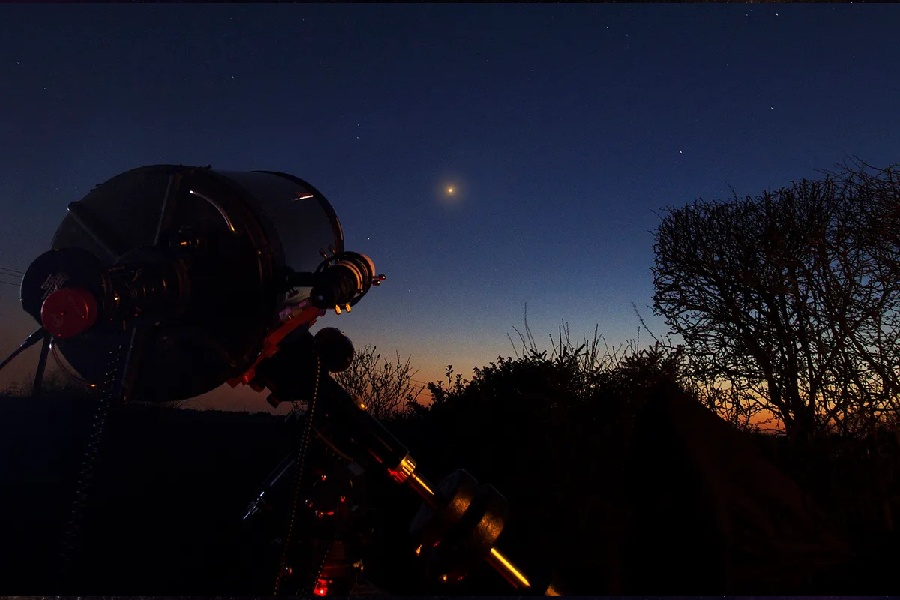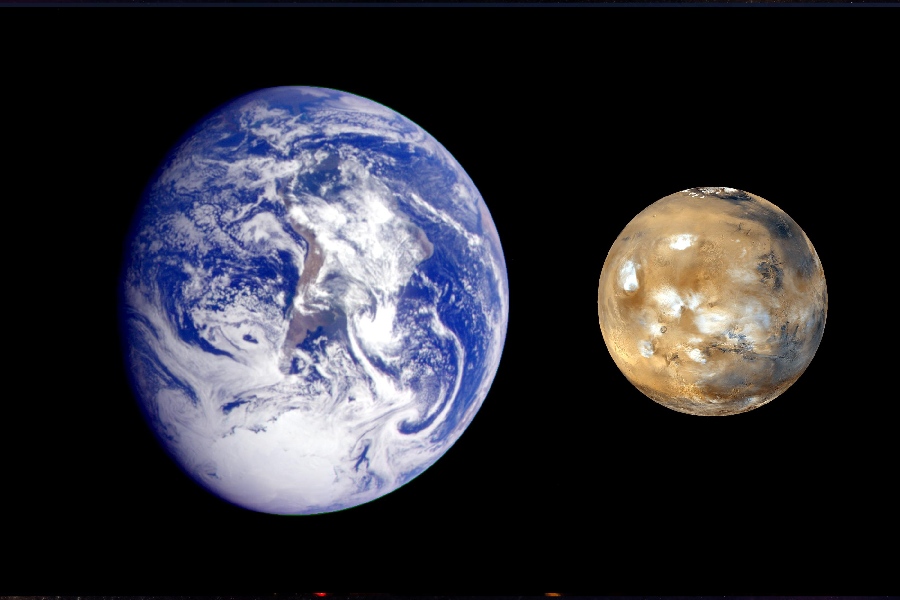Hovering as a reddish pinprick of light in the night sky, Mars has long captivated skywatchers who marvel at its visible presence. Mars’ visibility in the night sky fluctuates with its orbit relative to Earth, offering dynamic viewing opportunities. But is Mars visible at night?
This article will explore the factors that determine whether that tiny red dot will be visible on any given night. One can anticipate the next opportunity to observe this planet as it travels along its orbital path in our Solar System.
So, get ready to peer into the darkening sky!

Is Mars Visible at Night?
Yes, Mars is often visible at night. Due to its orbit around the Sun and its proximity to Earth, people can observe Mars in the night sky with the naked eye. It appears as a bright, reddish-orange object, particularly during its closest approach to Earth, known as opposition.
Opposition occurs roughly every two years. Mars is typically at its brightest and easiest to spot in the night sky during opposition. However, its visibility depends on various factors, such as atmospheric conditions and light pollution.
Finding Mars in the Night Sky
Mars is one of the brightest objects in the night sky, making it relatively easy to locate. However, its position in the sky changes constantly due to the motion of the planets around the Sun.
To find Mars, one needs to know its approximate location on a given night. This information is readily available in astronomy magazines, websites, and planetarium apps.
Once that is settled, use a star chart or a sky-mapping app to orient. Identify the constellation that Mars is currently passing through.
Distinguishing Mars from stars
Can Mars be seen at night amidst countless stars? It’s quite easy to distinguish Mars from the stars when one looks above in the night sky.
Unlike the fixed stars, which twinkle, Mars will appear as a steady, reddish-orange point of light. Its distinctive color comes from the iron oxide (rust) present in the Martian soil.
To confirm one’s sighting, watch the object for several minutes. While stars maintain their positions relative to one another, Mars will appear to move across the background of stars.
Another way to distinguish Mars is by its brightness. When favorably positioned, the Red Planet can outshine even the brightest stars in the night sky.
Best times for observation
The best time to observe Mars is when it’s at or near opposition – the point in its orbit where it lies directly opposite the Sun as seen from Earth. During opposition, Mars is at its closest and brightest in the sky.
However, even when not in opposition, Mars is visible for a large portion of the year, providing ample opportunities for skywatchers to enjoy its distinctive rusty hue.
Location of Mars in the Sky
Celestial coordinates
Like all celestial objects, Mars can be located in the sky using a system of celestial coordinates. These coordinates specify the object’s position relative to the celestial equator and the vernal equinox.
The primary coordinate system used for Mars is the right ascension (RA) and declination (Dec). Right ascension is similar to longitude on Earth, while declination is akin to latitude. By knowing Mars’ RA and Dec coordinates for a given date and time, observers can pinpoint its exact location among the stars and deep-sky objects.
Constellation tracking
Mars can be located by tracking its movement through the constellations of the zodiac. As Mars orbits the Sun, it appears to drift eastward against the background stars. Over several months, Mars traverses several constellations along the ecliptic, which is the path the Sun appears to take across the sky.
Astronomy resources often provide tables or charts indicating which constellation Mars will be passing through on specific dates. These aid observers in narrowing their search.
Rising and setting times
The rising and setting times of Mars also provide valuable information for locating it in the sky. These times vary depending on the observer’s location and the date.
When Mars rises or sets, it will be visible near the eastern or western horizon, respectively. Knowing these times can help plan observations and increase the chances of spotting the Red Planet.

When Is the Best Time to Find Mars?
Opposition and close approaches
As mentioned, the best time to observe Mars is during its opposition – when the Earth passes directly between Mars and the Sun. In opposition, Mars is at its closest point to Earth, appearing larger and brighter in the sky.
Oppositions of Mars occur roughly every 26 months, providing a window of several weeks or months when the planet is well-positioned for observation. In addition to oppositions, close approaches of Mars to Earth also offer excellent viewing opportunities, though they occur less frequently.
Visibility windows
Even when not in opposition, Mars is visible in the night sky for a significant portion of the year. However, its visibility and brightness vary depending on its position relative to Earth and the Sun.
The planet is generally the most prominent and easiest to spot when it’s high in the sky and viewable during convenient evening hours. Conversely, when Mars is on the opposite side of the Sun from Earth, it may be challenging to observe or entirely lost in the Sun’s glare.
Mars observing season
For observers in the Northern Hemisphere, the best season for viewing Mars is typically during the autumn and winter months. This is when the planet’s orbit brings it closest to Earth and highest in the night sky.
In the Southern Hemisphere, the prime Mars observing season is usually during the spring and summer months. However, the specific dates and durations may vary from year to year.
How bright will it be?
Apparent magnitude
The brightness of Mars, as seen from Earth, is measured by its apparent magnitude – a logarithmic scale used to quantify the brightness of celestial objects. The lower the apparent magnitude value, the brighter the object appears.
Mars can reach an apparent magnitude of around -2.9 at its brightest during opposition and close approaches. It outshines even the brightest stars like Sirius and Canopus.
However, Mars’ apparent magnitude can drop to around +1.8 when farther away from Earth. It can appear fainter than some of the most prominent stars.
Variation in brightness
Mars’ brightness in the night sky is not constant but varies considerably due to its elliptical orbit around the Sun and its changing distance from Earth. When closest to Earth during opposition, Mars shines at its maximum brightness. As it moves farther away, its brightness gradually diminishes until it reaches its dimmest point on the opposite side of its orbit.
This cyclical variation in brightness follows a predictable pattern. It allows observers to anticipate Mars’ appearance based on its current orbital position.
Surface features and dust storms
Apart from its distance, the apparent brightness of Mars can also be influenced by surface features and atmospheric conditions on the planet itself. The reflectivity of Mars’ surface, affected by factors like dust storms and the changing seasons, can cause slight fluctuations in its perceived brightness.
During global dust storms, Mars may appear slightly fainter. This occurs as the dust obscures more of the planet’s surface.
Tips for Locating and Identifying Mars
Use sky charts and apps
One of the most effective ways to locate Mars is by using sky charts, planetarium software, or mobile apps specifically designed for stargazing. These resources provide detailed information on the current positions of planets, stars, and deep-sky objects.
By inputting an individual’s location and the date and time, these tools can generate accurate sky maps. They can pinpoint the precise location of Mars among the stars.
Observe at dusk or dawn
Mars is often easiest to spot during the twilight hours, shortly after Sunset or before Sunrise. During these times, the planet’s reddish hue stands out more prominently against the darkening or brightening sky.
Observing Mars at these times can also help differentiate it from similarly colored stars. It may appear fainter or blend in with the background sky.
Look for the steady red “star”
What does Mars look like from Earth? When scanning the sky for Mars, keep an eye out for a steady, reddish-orange point of light that doesn’t twinkle like the stars. This distinctive color and non-twinkling appearance are telltale signs of Mars.
As one continues observing, they’ll notice the object’s motion against the background stars. This further confirms that they’ve found the Red Planet.
Use binoculars or a telescope
While Mars is often visible to the naked eye, using binoculars or a telescope can greatly enhance the viewing experience. These instruments make it easier to locate and identify Mars and reveal incredible details on the planet’s surface. Such details include polar caps, dark markings, and atmospheric features.
With the right equipment and observing conditions, observers may even be able to discern some of Mars’ most prominent geological features. One example is the vast Valles Marineris canyon system.
Conclusion
We hope this article helped observers understand better why and when the Red Planet is visible at night. So, is Mars visible at night? The answer is a resounding yes, especially during favorable oppositions when it shines brightly in our skies.
Knowing Mars’ cyclical patterns, celestial coordinates, and observing tips can maximize the chances of spotting and enjoying this enigmatic world. Whether with the naked eye, binoculars, or a telescope, observing Mars is a rewarding experience that brings us closer to unraveling the mysteries of our celestial neighbor.
